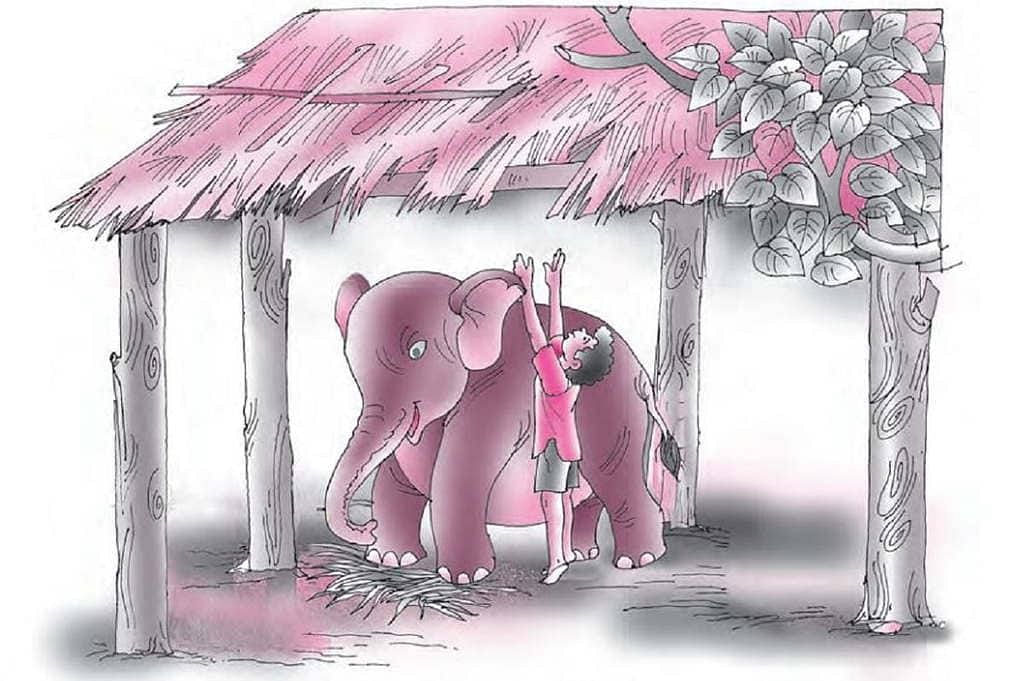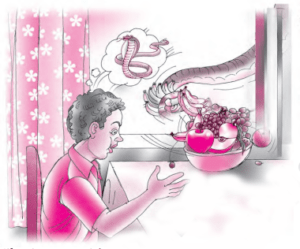NCERT Solutions for Class 7 English - Bringing Up Kari
Q.1: The enclosure in which Kari lived had a thatched roof that lay on thick tree stumps. Examine the illustration of Kari's pavilion on page 8 and say why it was built that way.
Ans: Kari's home had a special roof made of thatch, and it sat on four strong tree stumps. They built it like this so that even if Kari accidentally bumped into the poles while moving around, the roof wouldn't fall down. It was designed to keep Kari safe and make sure his home stayed sturdy.

Q.2: Did Kari enjoy his morning bath in the river? Give a reason for your answer.
Ans: Yes, Kari enjoyed his morning bath in the river. He would stretch out on the sandy riverbank, where the narrator would gently rub him with the pure river sand for an entire hour. Following that, he would recline in the water for an extended period. Once out of the water, his skin would gleam like ebony, and he would express his joy with delighted squeals as the storyteller rubbed water along his back.
Q.3: Finding good twigs for Kari took a long time. Why?
Ans: The narrator would ascend different types of trees to find the most gentle twigs for Kari. If a twig was not in shape, not even an elephant would be interested in it. As a result, discovering suitable twigs for Kari was a time-consuming process.
Q.4: Why did Kari push his friend into the stream?
Ans: Kari pushed his companion into the stream as another boy was struggling in the river. Kari, on his own, couldn't manage to bring him out of the water and he wished for the narrator to rescue the submerged boy.
Kari pushed his companion into the stream as another boy was struggling in the river. Kari, on his own, couldn't manage to bring him out of the water and he wished for the narrator to rescue the submerged boy.
Q.5: Kari was like a baby. What are the main points of comparison?
Ans: Kari was like a baby as it had to be trained to be good. If not corrected when mischievous, Kari tended to engage in even more mischief.  The main points of comparison are :
The main points of comparison are :
Teaching important lessons to Kari was essential. This shows that Kari needed guidance and training to learn proper behavior and conduct.
How Kari ate, sat, and engaged in daily activities needed instruction. This implies that not only moral lessons but also practical aspects of behavior needed to be taught.
Kari had a habit of taking fruits from the dining table without permission. This suggests he needed guidance in understanding proper boundaries.
Q.6: Kari helped himself to all the bananas in the house without anyone noticing it. How did he do it?
Ans:
There were big plates of fruit on a table by a window in the narrator's house. Kari managed to take all the bananas in the house without anyone noticing, using his long trunk. He would steal the bananas from the dining table through the window.
Q.7: Kari learnt the commands to sit and to walk. What were the instructions for each command?
Ans: The narrator trained Kari by giving him commands. To get Kari to sit down, the narrator would utter "Dhat" and gently pull his ear. For walking, the narrator used the word 'Mali' and guided Kari by pulling his trunk forward.
Q.8: What is “the master call?” Why is it the most important signal for an elephant to learn?
Ans:  The master call is an unusual mix of hissing and howling, resembling a snake and a tiger in a struggle, and it must be directed into an elephant's ear. This signal is crucial for elephants to learn because if someone is lost in the jungle and there is no way out, the only thing to do then is to give 'the master call'. This achieves two purposes: it scares away other animals, and it creates a path leading directly to one's home.
The master call is an unusual mix of hissing and howling, resembling a snake and a tiger in a struggle, and it must be directed into an elephant's ear. This signal is crucial for elephants to learn because if someone is lost in the jungle and there is no way out, the only thing to do then is to give 'the master call'. This achieves two purposes: it scares away other animals, and it creates a path leading directly to one's home.
|
7 videos|128 docs|40 tests
|
FAQs on NCERT Solutions for Class 7 English - Bringing Up Kari
| 1. How does the book "Bringing Up Kari" explore the theme of friendship? |  |
| 2. What is the significance of the title "Bringing Up Kari" in the context of the story? |  |
| 3. How does the character of Tilo evolve throughout the story "Bringing Up Kari"? |  |
| 4. What are some of the challenges faced by Tilo in raising Kari in the story? |  |
| 5. How does the story "Bringing Up Kari" emphasize the importance of empathy and understanding towards animals? |  |

|
Explore Courses for Class 7 exam
|

|


















